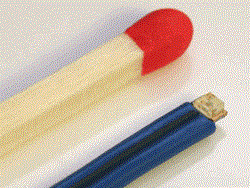Identifying different types of LEDs

Today’s LEDs & LED boards are available in many different types, shapes, and sizes, a direct result of the tremendous improvements we’ve seen in semiconductor technology over recent years. These advancements have led to better illumination, longer service life, and lower power consumption. They’ve also led to more difficult decision making, as there are simply too many types of LED to choose from.
To help organize everything, LEDs are broken down into three main categories, and their subtypes appropriately consolidated:
Category 1: Miniature
This is perhaps the most common form of LED available today. Miniature LEDs are considerably small, and usually available in a single shape/color. They’re used as indicators on devices such as cell phones, calculators, and remote controls.
Given their unique size and simple design, miniature LEDs can be placed directly onto a circuit board, with no need for a heat-controlling/cooling device. As such, they are also used in sophisticated and technologically intense automated industries.
There are three subtypes of miniature LEDs: low-current, standard, and ultra-high-output, all of which vary in terms of current, voltage, and total wattage, depending upon the manufacturer. There are 5- and 12-V miniature LEDs available, too. These particular lights are slightly different from standard miniature LEDs in that they incorporate a suitable series resistor so as to directly connect to a higher-power supply.
Category 2: High-power
Improved diode technology has resulted in this new category of LED, also referred to as a high-output LED as it offers a much higher lumen output than standard LEDs. In fact, their high-power chips can emit light that registers several thousand lumens. Subtypes of high-power LEDs are typically characterized by a few parameters, including voltage, wavelength, and luminous intensity.
It should be noted that these lights pose the danger of overheating and so need to be mounted on an appropriate form of heat-absorbent material to allow the heat to cool via convection. This keeps them productive and effective, and helps the light avoid an early burn-out.
A good rule of thumb: Always take heat control into consideration, no matter the type of high-power LED you are purchasing. Just as there are limits to maximum current, there are limits to certain temperatures, too. If a company claims to have manufactured the best-ever high-power LED, verify that there’s an appropriate balance between heat dissipation and output. When done properly, the reliability and longevity of the LED is better ensured, which, in the end, will help save you money.
You’ll typically find high-power LEDs in car headlights, high-powered lamps, and various mechanical, industrial, and scientific settings.
Category 3: Application-specific LED lights
The title of this category is fairly self-descriptive and there are several subtypes of LED that fall under it. Here are some of the most common:
Flash
Typically, the flashing LED is a standalone light that serves as a form of attention-seeking indication. It may look like a normal LED, but it contains an integrated circuit, in addition to the LED, which flashes the light at a specific frequency. Flashing LEDs are designed so as to be connected
directly to a power supply with no series resistor required. You can find them in things like vehicles, signs, etc.
Bi-color and Tri-color
A bi-color LED boards light has two light-emitting dies in a single casing. It features three leads and is offered with either a common anode or common cathode. The wiring for the bi-color LED is considered "inverse parallel”; that is, one is forward and one is backward. This means that only one of the dies can be lit at a time. Current flow alternates between dies in order to produce color variation. If you alternate the current at a high enough frequency, it will appear that both lights are on at the same time, and produce a third color.
Similar to a bi-color LED, the tri-color LED boards also combines two light emitting dies in one encasing. What’s different, though, is there are (usually) three leads instead. There’s a center lead, which is the common cathode for both LEDs, and on either side are the outer leads, which are the anodes to the separate LEDs. This design allows for both dies to be lit either separately or together which, when the colors are combined, produce a third color. Please note that while this example describes a common cathode-based design, tri-color LEDs are available in either a common anode or common cathode configuration
Latest Articles
- Familiar with a variety of LED modules
- The LED display
- Times Square’s Biggest and Most Expensive Digital Billboard Is Set to Shine
- Identifying different types of LEDs & LED boards-2
- Identifying different types of LEDs
- What is the full-color digital tube
- Training Tips full color modules
- what is SCROLLING BOARD Module
- Training on components of scRolling/ribbon/caption led board
- Controller board of SCROLLING BOARD


